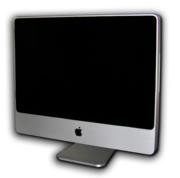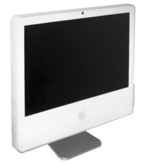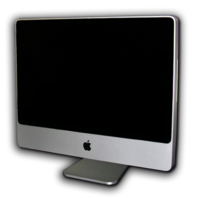This is an old revision of this page, as edited by 84.73.140.109 (talk) at 04:36, 14 September 2007 (Undid revision 157773116 by GnuTurbo (talk) Ample sources show that no Mac has ever been Santa Rosa/Centrino compliant). The present address (URL) is a permanent link to this revision, which may differ significantly from the current revision.
Revision as of 04:36, 14 September 2007 by 84.73.140.109 (talk) (Undid revision 157773116 by GnuTurbo (talk) Ample sources show that no Mac has ever been Santa Rosa/Centrino compliant)(diff) ← Previous revision | Latest revision (diff) | Newer revision → (diff)
The iMac is a midrange to high end desktop computer offered by Apple. The current Apple iMac features an Intel Core 2 Duo processor, ATI Radeon HD graphics, and an Intel Crestline chipset, offering up to 4 GB of RAM. Being one of the most iconic products of Apple Inc., the iMac is subject to many updates, and now features modern hardware in a new case. On August 7 2007, the iMac received a major facelift and update of hardware. Also, the iMac 17" was discontinued, leaving only the 20" model and the 24" models.
The iMac has an aluminum enclosure with a glass-coating, made to fit with the aluminum look of Mac OS X Leopard, the look of the Apple Cinema Displays (and other pro products), and the iPhone. The Apple keyboard has also been redesigned, in keeping with the aluminum look of the iMac, and is now slimmer and lighter.
History
At the Macworld Conference and Expo on January 10 2006, Steve Jobs announced that the new iMac would be the first Macintosh to use an Intel CPU, the Core Duo. The features and price remained unchanged from the iMac G5. Aesthetically, it looks similar to the G5, but the optical drive was moved down slightly and the ports were changed from vertically stacked to horizontally aligned. The processor speed, according to tests run by Apple using SPEC, was declared as two to three times faster.
In early February 2006, Apple confirmed reports of video display problems on the new Intel-based iMacs. When playing video on Apple's Front Row media browser, some 20-inch iMacs (those built-to-order with upgraded video cards) showed random horizontal lines, ghosting, video tearing and other problems. The problem was fixed with a software update.
The current iMac ships with the Mighty Mouse, keyboard, Bluetooth and AirPort cards, an internal iSight camera, the Apple Remote for use with Front Row, and a power cord. A Bluetooth wireless keyboard and mouse are available for additional cost.
In late 2006, Apple introduced a new version of the iMac which included a Core 2 Duo chip and a lower price. Apple added a new 24" model with a resolution of 1920×1200 (WUXGA), making it the first iMac to be able to display 1080 HD content in its full resolution, and a VESA Flat Display Mounting Interface. Except for the 17–inch 1.83 GHz processor model, this version also included an 802.11n draft card.
Models
iMac (Early 2006)
 The iMac (Early 2006). The iMac (Early 2006). | |
| Developer | Apple Inc |
|---|---|
| Type | Desktop |
| Release date | January 10 2006 |
| Introductory price | US$1,299–US$1,699 |
| CPU | Intel Core Duo, 1.83–2.0 GHz |
January 10 2006 — Apple updated the iMac G5 to Intel processors, claiming up to 2–3× performance improvement.
- 17-inch model (MA199LL), 1.83 GHz 32-bit Intel Core Duo
- 20-inch model (MA200LL), 2.0 GHz 32-bit Intel Core Duo
- All Intel-based Core Duo iMacs shipped with iLife '06
- A PCI-Express ATI Radeon X1600 graphics processor with 128 MB GDDR3 VRAM - 256 MB option on the 2.0 GHz model
- 512 MB PC2-5300 (667 MHz) DDR2 SO-DIMM SDRAM; expandable to 2.0 GB total memory (dual channel capable)
- SATA hard disk (160 GB on 17-inch and 250 GB on 20-inch) with native command queuing support
- Mini-DVI output with extended desktop support (it can drive up to a 23-inch Apple Cinema Display)
- Note: Although iSight provides up to 4× the resolution of the iMac G5, when using it with iChat, it is still limited to 640 × 480 resolution.
A low-end version of the 17-inch model was introduced July 5 2006, for education customers only, replacing the eMac (now discontinued). Priced at US$899, the "Educational Configuration" iMac is the same as the regular 17-inch model but instead comes with a combo optical drive, an 80 GB hard drive, and integrated graphics (Intel GMA 950), and lacks Bluetooth and the Apple Remote. For the first week after its release this model was available to individual educators. A week after its introduction, however, it was pulled by Apple from the educational consumer online store without explanation and limited to purchases by educational institutions only.
iMac (Mid 2006)
 The iMac (Mid 2006). The iMac (Mid 2006). | |
| Developer | Apple Inc |
|---|---|
| Type | Desktop |
| Release date | September 6 2006 |
| Introductory price | US$999–US$1,999 |
| CPU | Intel Core 2 Duo, 1.83–2.33 GHz |
September 6 2006 — Apple updates to Core 2 Duo (64-bit, Merom) processors with new models in four default configurations.
Apple claimed these were up to 50% faster than the previous Core Duo models. Apple also cut prices on the lowest end iMac from US$1299 to US$999, and made the Apple Remote optional on the US$999 17-inch model. Options for graphics cards included the same options as the iMac Core Duo, but the low end 17-inch model used Intel GMA 950, and the 24-inch model had an NVIDIA GeForce 7300 GT graphics card with an upgrade option of a 7600 GT. The base RAM for all but the base model was raised from 512 MB to 1 GB, and the maximum allowable RAM for all but the base model was increased to 3 GB. The 24-inch model's 1920 × 1200 resolution supported full 1080p high-definition.
- 17-inch model (MA590LL), 1.83 GHz 64-bit Intel Core 2 Duo
- 20-inch model (MA589LL), 2.16 GHz 64-bit Intel Core 2 Duo (2.33 GHz optional)
- 24-inch model (MA456LL), 2.16 GHz 64-bit Intel Core 2 Duo (2.33 GHz optional)
- All Intel-based Core 2 Duo iMacs shipped with iLife '06
- An Intel GMA 950 graphics chip or PCI-Express ATI Radeon X1600 graphics processor with 128 MB GDDR3 VRAM - 256 MB option on the 2.0 GHz model, NVIDIA GeForce 7300 GT with 128 MB GDDR3 memory
- 512 MB PC2-5300 (667 MHz) DDR2 SO-DIMM SDRAM on the base model; 1 GB standard on others and expandable to 3.0 GB total memory (dual channel capable)
- SATA hard disk (160 GB on 17-inch and 250 GB on 20-inch) with native command queuing support
- Mini-DVI output with extended desktop support, capable of driving a 23-inch Apple Cinema Display).
iMac (Mid 2007)
 The iMac (Mid 2007) The iMac (Mid 2007) | |
| Developer | Apple Inc |
|---|---|
| Type | Desktop |
| Release date | August 7 2007 |
| Introductory price | US$1199–US$1,799 |
| CPU | Intel Core 2 Duo, 2.0–2.4 GHz; Intel Core 2 Extreme 2.8 GHz; |
| Website | http://www.apple.com/imac/ |
Inside the new iMac is Intel's latest Crestline chipset, recently placed in the MacBook Pro laptops, with Intel Core 2 Extreme processor capability, faster data bus, and 4 GB RAM support. The new design is thinner than the last generation, and is made of aluminum and glass. Apple has stated that these materials are fully recyclable. Many other small aesthetic changes are present, such as the back of the prior Intel iMac the word iMac was shown; this has now been replaced by an Apple logo. The 17" model has been discontinued by Apple, being replaced by a cheaper 20" model.
The 20-inch 2.0 GHz iMac, for a retail price of US$1,199, includes:
- 20-inch widescreen LCD display (1680×1050 native resolution);
- 2.0 GHz 64-bit Intel Core 2 Duo processor (T7300);
- 1 GB of 667 MHz DDR2 SDRAM expandable to 4 GB;
- 8× SuperDrive with double-layer support (DVD+R DL/DVD+/-RW/CD-RW);
- ATI Radeon HD 2400 XT with 128 MB of GDDR3 memory
- Built-in iSight video camera;
- Built-in AirPort Extreme wireless networking;
- Firewire 400/800 Ports
- 250 GB Serial ATA hard drive running at 7200 rpm;
- Mini-DVI out (adapters for DVI, VGA and Composite/S-Video sold separately);
- Built-in stereo speakers and microphone;
- Mighty Mouse and a newly redesigned Apple Keyboard;
- Apple Remote;
- 24 watt amplifier w/ included speakers.
The 20-inch 2.4 GHz iMac, for a retail price of US$1,499, includes everything from the 20-inch 2.0 GHz iMac, with these changes:
- 2.4 GHz 64-bit Intel Core 2 Duo processor (T7700);
- 320 GB Serial ATA hard drive running at 7200 rpm;
- ATI Radeon HD 2600 PRO with 256 MB of GDDR3 memory.
The 24-inch 2.4 GHz iMac, for a retail price of US$1,799, includes everything from the 20-inch 2.4 GHz iMac, with these changes:
- 24-inch widescreen LCD display (1920×1200 native resolution)
- The 24" 2.8 GHz iMac with a retail price of $2299, includes everything from the 24" 2.4 GHz model, with only these minor exceptions:
- 2.8 GHz Intel Core 2 Extreme processor (X7900);
- 2 GB of 667 MHz DDR2 SDRAM expandable to 4 GB;
- 500 GB Serial ATA hard drive running at 7200 rpm.
| Timeline of iMac and eMac models |
|---|
 See also: List of Mac models See also: List of Mac models
|
See also
References
- "Apple delivers new iMacs, iLife and iWork '08". Nick dePlume. Retrieved 2007-09-05.
- "Apple - iMac - Intel Core Duo". Apple Inc. Retrieved 2007-03-01.
- AirPort Extreme performance page see footnote 2
- Thom Holwerda. "Apple Announces Intel iMac, MacBook Pro, OS X 10.4.4, More". Retrieved 2007-02-26.
- http://images.apple.com/imac/pdf/20060120_iMac_TO.pdf (PDF)
- Teresa Weaver. "Apple iMac Line Now Features Intel Core 2 Duo Processors in Every Model". Retrieved 2007-02-26.
| Apple hardware since 1998 | |||||
|---|---|---|---|---|---|
| Mac |
| ||||
| iPhone | |||||
| iPad | |||||
| iPod | |||||
| Other consumer electronics | |||||
| Accessories | |||||
| Silicon | |||||
| See also template: Apple hardware before 1998 | |||||